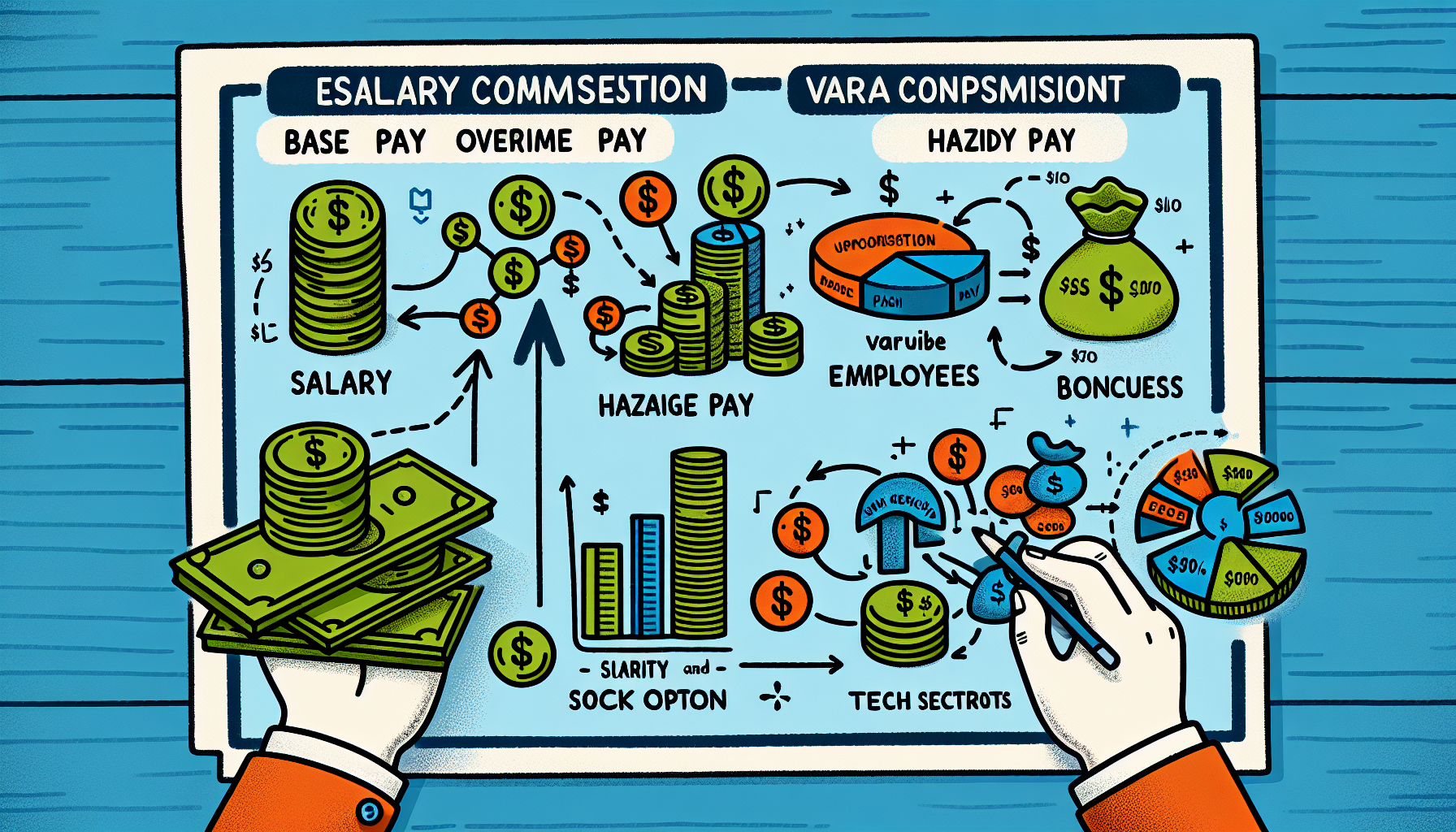The ABCs of Employees: A How-to Guide for Employers
The ABCs of Employees: A How-to Guide for Employers
Effectively managing employees is pivotal for any company’s success. Beyond just hiring the right staff, it involves understanding the nuances of employee classification, the dynamics of the employee-employer relationship, and how the law protects workers’ rights. A strong professional introduction can set the tone for mutual respect and confidence, enhancing the employee experience and making interactions more engaging and productive. Success in this realm not only boosts a company’s reputation but also its workplace culture and organizational performance, underscoring the importance of organizational consulting.
This article delves into the ABCs of managing employees, covering everything from understanding the diverse roles employees play to navigating legal protections, the intricacies of benefits and compensation, and best practices in recruitment and retention. With a focus on leadership coaching, engagement, diversity, and training, employers can cultivate an environment that fosters employee satisfaction and propels organizational success. It will also look at the current challenges in the job market, providing insights into how employers can support their workforce through effective workforce transformation.
Understanding Employee Classification
Correctly classifying employees is essential for compliance with labor laws and ensuring fair treatment. According to the Fair Labor Standards Act (FLSA), it’s crucial to distinguish between exempt and non-exempt employees. Exempt employees, who are typically salaried professionals, aren’t eligible for overtime pay regardless of hours worked, while non-exempt workers must receive overtime pay at a rate of one and a half times their regular hourly wage for any hours worked beyond the standard 40-hour workweek.
Key Classifications Under FLSA
- Exempt EmployeesExempt employees are paid on a salary basis of at least $684 per week and work in professions exempt from overtime, such as executive, administrative, and professional roles. These employees play a crucial role in the operational efficiency of any organization.
- Non-Exempt EmployeesNon-exempt employees, often paid hourly, are entitled to overtime pay and must be compensated for any hours worked beyond the standard 40-hour workweek. Their roles are vital in ensuring operational success across various sectors.
- Independent ContractorsIndependent contractors are not considered employees; they do not receive benefits and are responsible for their own taxes and insurance. This classification reflects the diverse workforce landscape and the importance of understanding different worker roles.
- Temporary and Part-Time EmployeesBoth part-time and temporary employees are eligible for FLSA benefits, with part-time employees working fewer than 40 hours per week and temporary employees hired for specific periods. Recognizing these distinctions is key to maintaining compliance and fairness.
Employers face crucial decisions between hiring independent contractors and permanent employees, each with distinct legal and financial implications. Misclassification can lead to significant penalties, including back payment of wages, taxes, and benefits. Thus, understanding the legal definitions and criteria set by the FLSA is essential for every employer to avoid costly mistakes and ensure that all workers receive their rightful benefits and protections.
The Role and Responsibilities of Employees
Employees are tasked with a variety of roles and responsibilities essential for the smooth operation of any organization. They must diligently carry out duties as per their employers’ instructions, including being proactive in meetings, contributing ideas, and engaging thoroughly in workplace activities. Each worker must also perform their hired work with care and seriousness, avoiding actions that could endanger themselves or others.

In addition to operational tasks, employees play several critical roles within the company, serving as customer advocates, trainers, resources, skilled workers, team players, decision makers, and problem solvers. This multi-faceted involvement is crucial for enhancing the overall productivity and efficiency of the organization. Employees are also expected to adhere to the company’s policies and contribute to its success by being loyal and honest, following their employer’s instructions unless these instructions are dangerous or illegal.
Employee rights and protections stand as a cornerstone of their roles, ensuring they receive a written employment contract, a guaranteed minimum wage, and a cap on work hours at 48 per week, with the option to decline overtime. These protections extend to safeguarding against unauthorized wage deductions, ensuring rest breaks, and upholding a discrimination-free workplace. Essential safety gear must be provided, and any changes to the employment terms require prior consultation. Furthermore, employees benefit from designated paid leaves, such as sick leave and parental leave, fostering a fair and secure working environment.
Types of Employees
Full-time Employees
Full-time employees, who typically clock in around 40 hours per week, are privy to a suite of benefits. Notably, companies with a workforce of 50 or more full-time employees are obligated to provide healthcare coverage for them and their dependents, offering not just job security but also crucial health and welfare benefits that might elude part-time or temporary staff.
Part-time and Temporary Employees
Part-time employees, logging less than 40 hours weekly, usually earn hourly wages instead of a fixed salary and might miss out on the benefits that full-time employees enjoy, impacting their financial and job security. Temporary employees, hired for specific durations or projects, also find themselves outside the benefits umbrella, offering employers the advantage of staffing flexibility without the commitment to long-term benefits.
Other Classifications
- Seasonal EmployeesSeasonal employees, brought on board during busy periods like summer or winter holidays, play a vital role in handling extra workloads. They qualify for Social Security and unemployment benefits, which offers a layer of security throughout their tenure.
- Leased EmployeesContract workers, sourced through staffing agencies for assignments typically lasting a year or more, enjoy benefits via their agencies rather than the companies they serve, marking a distinct employment arrangement.
- InternsInterns, often students or recent graduates, may engage in unpaid or paid roles, sometimes in pursuit of college credit. Their primary objective is to gain practical experience in their field of study.
- FreelancersFreelancers, hired for specific tasks at an agreed day rate, offer companies a flexible and cost-effective workforce solution. Unlike traditional employees, freelancers usually do not receive company benefits, reflecting the gig economy’s dynamics.

Each employee type serves a unique function within the corporate ecosystem, contributing to the organization’s needs and adapting to the ever-changing business landscape.
Legal Protections for Employees
In California, employees are supported by a legal framework designed to uphold fair labor practices and ensure safe working conditions. Employers must comply with regulations that include paying the minimum wage and granting mandatory rest and meal breaks. For instance, non-exempt employees are entitled to a 30-minute lunch break for shifts exceeding five hours. Additionally, maintaining a safe workplace is crucial, necessitating the identification and mitigation of health and safety risks, keeping a written health and safety plan, and documenting all workplace injuries and illnesses.
Employees also have the right to raise concerns about unpaid wages, report injuries or safety hazards, and lodge claims or complaints with state agencies without fear of retaliation. This empowerment allows them to form or join groups to advocate for changes, further shielding them from any negative actions by employers. In the event of a workplace injury, employers are responsible for covering medical expenses for work-related injuries and illnesses, ensuring that employees receive the care they need without the financial strain.
The legal landscape extends beyond state-specific laws to encompass federal regulations that offer additional safeguards for employees. The Fair Labor Standards Act (FLSA) sets a national minimum wage and mandates overtime pay for nonexempt employees working over 40 hours per week. The Occupational Safety and Health Act (OSHA) outlines essential safety guidelines and protects employees from retaliation when reporting workplace issues. Furthermore, the Family and Medical Leave Act (FMLA) provides up to 12 weeks of unpaid leave for eligible employees needing time off for specific family and medical reasons, ensuring job security during critical times. These laws collectively forge a robust legal framework to protect employee rights and foster a fair and safe working environment.
Benefits and Compensation
Compensation and benefits form the cornerstone of an effective employee management strategy, directly influencing recruitment, retention, and overall job satisfaction. Employers offer a variety of rewards, including salaries, bonuses, insurance, retirement contributions, and other perks to compensate employees for their labor. These benefits are not just crucial for attracting top talent but also for keeping employees motivated, engaged, and loyal to the company. Incorporating compensation consulting strategies can further enhance this cornerstone, ensuring a competitive and comprehensive approach.

Types of Compensation and Benefits
- Salary and WagesThis includes base pay and may involve overtime pay or hazard pay where applicable, highlighting the importance of meticulous payroll management to ensure every employee is compensated fairly for their contributions.
- Variable Compensation: Often linked to performance metrics, including bonuses and commissions.
- Equity and Stock OptionsMainly offered to senior employees or those in higher-tech sectors, providing a stake in the company’s success serves as a testament to the value placed on employee contributions across all levels.
- Benefits for Health and Financial Security: Encompasses health insurance, life insurance, disability insurance, and retirement plans like 401(k)s.
- Lifestyle BenefitsBenefits may include flexible working hours, remote work options, paid time off, and wellness programs, all designed to support employee well-being and work-life balance.
Employers must ensure that compensation and benefits adhere to market standards to maintain fairness and competitiveness. For instance, the Trinity River Authority offers a comprehensive benefits package, including Health Savings Account contributions and various insurance options, ensuring their employees receive substantial financial and health security.
Effective management of compensation involves regular assessments and adjustments based on compensation metrics like salary range penetration and compa-ratio. These metrics help HR departments maintain competitive and fair compensation strategies that align with both budget constraints and employee expectations. Additionally, offering cost-effective perks such as free lunches, company-sponsored discounts, or extra time off can significantly enhance job satisfaction without a substantial increase in expenses.
The Employee-Employer Relationship
The foundation of any successful organization lies in the robust relationship between employers and employees, characterized by clear communication and mutual respect. Both parties benefit from a well-defined understanding of their roles, responsibilities, and rights. Employers should initiate this relationship with comprehensive onboarding processes that outline expectations clearly and set the stage for open dialogue. This approach not only clarifies the job scope and organizational policies but also fosters a sense of belonging and commitment from the outset.
Enhancing Interaction through Strategic Practices
To nurture a positive and productive workplace, organizations implement various strategies aimed at strengthening the bond between staff and management. These include:
- Regular Performance Feedback: Constructive critiques paired with recognition of achievements motivate employees and clarify performance expectations.
- Professional Development OpportunitiesTraining programs and career advancement options that align with employee goals and organizational needs underscore the importance of succession planning in fostering a supportive and growth-oriented work environment.
- Flexible Work Arrangements: Adapting work schedules to accommodate different needs, enhancing employee satisfaction and productivity.
- Inclusive and Diverse Workplace InitiativesPromoting a culture where every employee feels valued and included, irrespective of their background ensures a harmonious and productive workplace.
These strategies are pivotal in creating an environment where employees are engaged, motivated, and aligned with the company’s goals, fostering a sense of unity and purpose.
Building a Culture of Appreciation and Growth
A strong employee-employer relationship is also heavily reliant on the intangible aspects of workplace culture. Employers must be genuine in their interactions, offering consistent support and showing flexibility to accommodate individual needs. Celebrating both small wins and major milestones alike contributes to a positive atmosphere where employees feel valued. Additionally, providing a platform for employees to voice their opinions and concerns openly not only empowers them but also gives employers valuable insights into improving workplace practices and policies. This two-way street of feedback and acknowledgment underpins a dynamic and responsive work environment, crucial for both personal and organizational growth.
Hiring and Managing Employees
Hiring and managing employees are pivotal aspects of building a successful team and fostering a productive workplace environment. Ensuring that these processes are handled effectively can significantly impact employee satisfaction and retention, ultimately influencing the company’s overall performance.
Onboarding and Orientation
Effective onboarding starts with a structured orientation process that introduces new employees to the company culture, values, and expectations. Key steps include:
- Preparation Before ArrivalSetting up a workstation with necessary supplies and ensuring access to required tools and technologies.
- First Day ActivitiesProviding a comprehensive orientation that covers everything from company policies to job responsibilities, and assigning a mentor for guidance.
- Initial Projects and TrainingEngaging new hires with starter projects tailored to their roles and offering role-specific training to help them integrate smoothly into their new positions.
Legal and Compliant Recruitment
It’s crucial for employers to conduct the hiring process legally and ethically to avoid complications and ensure fairness. This involves:
- Writing Clear Job Descriptions: Outlining the necessary skills and qualifications and posting them on relevant job boards.
- Conducting InterviewsUtilizing best practices for interviewing while ensuring all questions are compliant with employment laws, and adopting executive search techniques to find the best fit for the company.
- Background Checks and DocumentationVerifying candidate information through references and background checks and ensuring all new hires complete necessary forms like W-4 and I-9 is a critical step in the executive search and employee onboarding process.

Managing and Supporting Employees
Once employees are part of the organization, managing them effectively involves continuous support and development. Employers should:
- Provide Continuous Training and SupportOffer ongoing training programs to enhance employee skills and provide support through regular feedback and performance evaluations.
- Ensure a Safe and Respectful WorkplaceMaintain a workplace that is safe from physical hazards and free from harassment or discrimination to ensure employee well-being.
- Foster Open CommunicationEncourage employees to share their ideas and concerns, facilitating regular team meetings, and maintaining clear, open lines of communication.
By focusing on these key areas, employers can create a robust system for hiring and managing employees that not only complies with legal standards but also promotes a healthy, engaging, and productive work environment.
Challenges Facing Employees Today
Employees today face a myriad of challenges that can impact their job satisfaction, performance, and overall workplace harmony. Understanding these challenges is crucial for employers to foster a supportive and productive work environment.
Communication and Diversity Challenges
One of the primary hurdles in the workplace includes establishing effective communication channels. Misunderstandings or lack of communication can lead to frustration and decreased productivity. Additionally, fostering an inclusive environment that respects and celebrates diversity remains a challenge. Employers must navigate various cultural, linguistic, and personal backgrounds to create a cohesive team.
Leadership and Career Advancement
The impact of leadership styles and management approaches on employee morale cannot be overstated. Leadership that fails to inspire or adequately support employees can lead to a disengaged workforce. Moreover, clear pathways for career growth and advancement are essential for employee retention. Without these, employees may feel stagnant and undervalued, prompting them to seek opportunities elsewhere.
Work-Life Balance and Technology Integration
Maintaining a healthy work-life balance is increasingly challenging in a world where technology often blurs the lines between personal and professional life. Employees are finding it difficult to disconnect from work, leading to burnout and reduced productivity. Integrating technology in the workplace also presents challenges, including training employees on new systems and ensuring that technology enhances rather than hinders their work processes.
Conclusion
Throughout this exploration of employee management, we have journeyed from understanding the foundational classifications of employees and their key responsibilities to navigating the legal landscape that protects them. We’ve dissected the elements that create a robust employee-employer relationship, including the importance of benefits, compensation, and a healthy workplace culture. These components are integral to fostering a productive, engaged, and satisfied workforce. The discourse also illuminated the challenges that today’s employees face, highlighting the need for effective communication, leadership, and the balancing act between work and life that technology demands.
As employers, it is incumbent upon us to continuously evolve our practices to meet the dynamic needs of our workforce. The insights presented serve as a guiding framework for creating an inclusive, respectful, and motivating environment that not only attracts but retains top talent. In focusing on compassionate and equitable management strategies, we pave the way for a future where both organizations and their employees flourish. This call to action is not just a conclusion of our discussion but a beginning for leaders ready to make a meaningful impact in the lives of their employees and, consequently, the success of their organizations.
Question 1: What are the key classifications of employees under the Fair Labor Standards Act (FLSA)?
Answer: The FLSA identifies four main classifications of employees:
Exempt Employees: These are salaried professionals who are not eligible for overtime pay.
Non-Exempt Employees: These employees are often paid hourly and must receive overtime pay for any hours worked beyond the standard 40-hour workweek.
Independent Contractors: These are not considered employees and are responsible for their own taxes and insurance.
Temporary and Part-Time Employees: Both part-time and temporary employees are eligible for FLSA benefits, with part-time employees working fewer than 40 hours per week and temporary employees hired for specific periods.
Question 2: What are some of the legal protections for employees?
Answer: Employees are protected by a variety of state-specific and federal laws. These include the Fair Labor Standards Act (FLSA) which mandates minimum wage and overtime pay, the Occupational Safety and Health Act (OSHA) which outlines safety guidelines, and the Family and Medical Leave Act (FMLA) which provides unpaid leave for specific family and medical reasons.
FAQ
Question 3: What are the key components of an effective employee management strategy?
Answer: An effective employee management strategy includes:
Compensation and Benefits: These include salaries, bonuses, insurance, retirement contributions, and other perks.
Performance Feedback: Regular critiques and recognition of achievements.
Professional Development Opportunities: Training programs and career advancement options.
Flexible Work Arrangements: Adapting work schedules to accommodate different needs.
Inclusive and Diverse Workplace Initiatives: Promoting a culture where every employee feels valued and included.
Question 4: What are some of the challenges facing employees today?
Answer: Some of the challenges facing employees today include communication and diversity challenges, leadership and career advancement issues, maintaining a healthy work-life balance, and integrating technology in the workplace.


